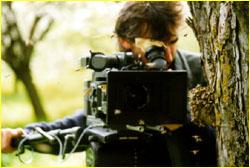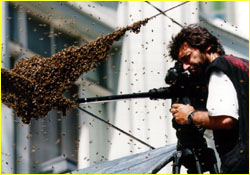
|
 |
|
The Making of Part 3 | Back to Part 2 NOVA: For "Tales From the Hive," did you have to build any special viewing platforms to shoot inside the nest? Thaler: Directors of other bee films have typically brought honeycombs into daylight and shot them with macro lenses. I wanted to show the viewer an approximate picture of a bee city, so we built a mini-studio outdoors that was absolutely pitch-black. In that studio, six bee populations (including the population seen in the apple tree in the film) were set up so that the bees could make an unhindered escape down a corridor to the outside. We built the respective sets with empty honeycombs, set up the lights - which were very small light sources, partially reflected by mirrors—and positioned the camera. As soon as everything was set up, we replaced the empty honeycombs with full ones from the bee population, which gave us two to three minutes to get the shot. That's why it took an average of two hours for a good set up.
NOVA: When working the hive, do the bees get used to your presence and leave you alone? Why wasn't the beekeeper attacked when he kidnapped the queen for marking? Thaler: When the weather is nice and nature offers the bees a plentiful supply of nectar and pollen, it's very easy to work with them, because all the bees are thinking about is honey production. They must know (or you have to know) that only during a few weeks of the year, nature gives bees the opportunity to collect enough honey reserves for the winter. On such days, they let anything be done to them. When the weather changes during such a phase, however, they react aggressively to any disruption by humans. Unfortunately, very often we had bad weather, and on such days, not just the beekeeper but the whole team got stung many times. NOVA: In the scene where the bear attacks the hive in the log, were you alerted when the bear arrived in the area, or was it serendipity that you happened to capture its attack on film? Thaler: In Austria, bears have begun to appear again over the past few years. They are very shy, and it is a big coincidence to meet a bear in the woods. We had to shoot this sequence with a bear who is used to humans. The enterprise was not entirely harmless, however. We built a cave for the bee population in the woods and filled it with large honey reserves. The scent of the honey lured the bear to the scene, and the story developed from there. We had no control over how and from where the bear would dig out the bee population. Towards the end of the scene, he became quite wild and unpredictable, because numerous bees had stung him on the snout.
Thaler: Sometimes it happens that an entire swarm gets lost in a city, and though we arranged this scene, it is is not fictional but really happened in Vienna a few years ago. The scene posed a major headache for the beekeeper, because the wire was very thin, and it was hard for the bees to form a swarm cluster. Yet I was convinced from the beginning that the scene would work. The trick was really simple. First we caught the queen from a population and put her into a cage. Then we added five or six pounds of flight bees and shut them in a box for two days. We fixed the queen's cage to the tram wire, opened the box, and because the bees are obsessed with their queen, they began immediately to search the nearby environment. They soon found the queen, because her scent is easy to pick out, and within minutes all bees from the box assembled on the tram wire. My job was to shoot this scene from many different angles during these few minutes; I just had to be really fast. Photos: (1,4-9) Courtesy of Wolfgang Thaler; (2,3) ©1998 ORF. The Making of | Anatomy of a Hive The Buzz About Bees | Dances With Bees Resources | Transcript | Site Map | Tales from the Hive Home Editor's Picks | Previous Sites | Join Us/E-mail | TV/Web Schedule About NOVA | Teachers | Site Map | Shop | Jobs | Search | To print PBS Online | NOVA Online | WGBH © | Updated October 2000 |
 Thaler films a honeybee colony that has set up shop
within the hollow trunk of an apple tree.
Thaler films a honeybee colony that has set up shop
within the hollow trunk of an apple tree.
 With bees hovering all around him, Thaler films the
swarm on the tram wire in Graz, Austria.
With bees hovering all around him, Thaler films the
swarm on the tram wire in Graz, Austria.